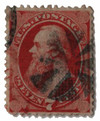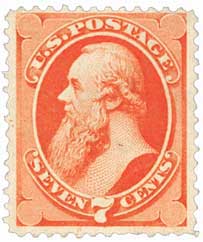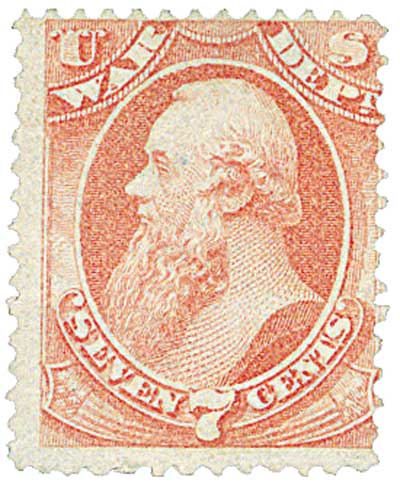
# 138A - 1871 7c Stanton, vermilion 'I Grill'
1870-71 7¢ Stanton
National Bank Note Printing
I Grill
Earliest Known Use: February 12, 1871
Quantity issued: 800,000 (estimate)
Printed by: National Bank Note Company
Method: Flat plate
Watermark: None
Perforation: 12
Color: Vermilion
Birth Of Edwin Stanton
As a child, Stanton attended private and seminary schools. He suffered from severe asthma that prevented him from participating in strenuous physical activities. So he took a great interest in books and poetry.
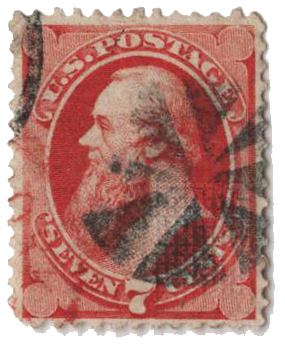
After his father died, Stanton had to leave school to help earn money for the family. He worked at a bookseller before briefly attending Kenyon College. He was unable to finish his studies there because of his family’s financial woes. So he returned to working in a book store. Stanton then decided to study law.
After being admitted to the bar, Stanton opened a successful practice in Cadiz, Ohio, where he also worked with an anti-slavery society and wrote for and edited the local newspaper. In 1837, he was made prosecutor of Harrison County. Stanton soon grew more involved in politics and his law practice spread to Virginia and Pennsylvania.
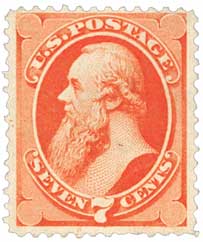
In 1859, Stanton argued one of his most famous cases, serving as the defense attorney for Daniel E. Sickles. Sickles was on trial for the murder of his wife’s lover, Philip Barton Key II (the son of Francis Scott Key). Sickles was eventually acquitted after Stanton became one of the first US attorneys to use an insanity defense.
The following year, Stanton left his law practice when he was appointed attorney general under James Buchanan. Stanton reportedly convinced Buchanan to drop his policy of secession tolerance and denounce it as illegal.
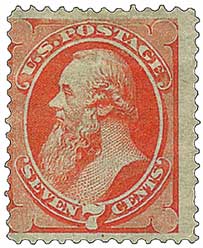
After Lincoln’s election to the presidency, he asked Stanton to become an advisor to the secretary of war, Simon Cameron. In 1862, Stanton replaced the inefficient secretary. As the War Department grew, Stanton organized it to run smoothly. Stanton was effective in his new role and rigorously persecuted all officers suspected of being traitors. He also issued an order to arrest anyone helping the South or hindering the Union cause.
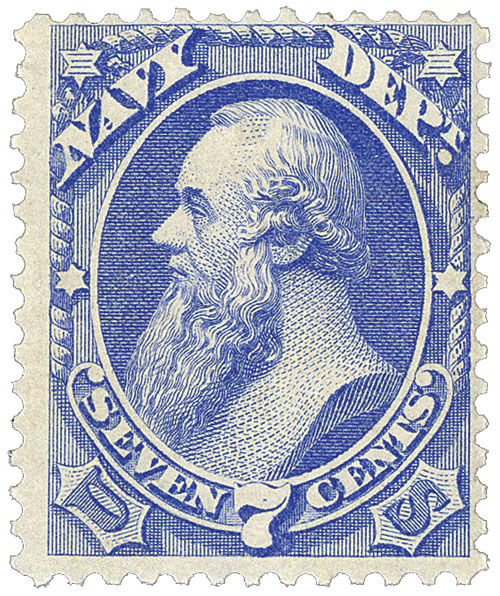
Though they didn’t always see eye to eye, Stanton and Lincoln had mutual respect. Lincoln once said of Stanton, “He is the rock on the beach of our national ocean against which the breakers dash and roar… without ceasing. He fights back the angry waters and prevents them from undermining and overwhelming the land… I do not see how he survives, why he is not crushed and torn to pieces. Without him I should be destroyed.”
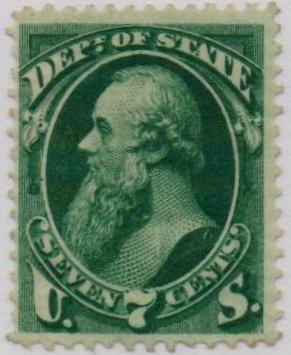
Upon Lincoln’s assassination in 1865, Stanton rushed to the scene and took charge. When Lincoln died, Stanton famously stated, “Now he belongs to the ages. There lies the most perfect ruler of men the world has ever seen.” Stanton then oversaw the manhunt for John Wilkes Booth.
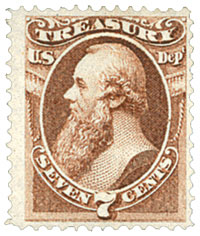
Stanton retained his position under President Andrew Johnson. However, when he disagreed with Johnson’s Reconstruction policies, the president attempted to replace him. Johnson was nearly impeached over the incident. Stanton subsequently resigned to practice law. He was later appointed to the Supreme Court by President Ulysses S. Grant, but died four days later on December 24, 1869.
1870-71 7¢ Stanton
National Bank Note Printing
I Grill
Earliest Known Use: February 12, 1871
Quantity issued: 800,000 (estimate)
Printed by: National Bank Note Company
Method: Flat plate
Watermark: None
Perforation: 12
Color: Vermilion
Birth Of Edwin Stanton
As a child, Stanton attended private and seminary schools. He suffered from severe asthma that prevented him from participating in strenuous physical activities. So he took a great interest in books and poetry.

After his father died, Stanton had to leave school to help earn money for the family. He worked at a bookseller before briefly attending Kenyon College. He was unable to finish his studies there because of his family’s financial woes. So he returned to working in a book store. Stanton then decided to study law.
After being admitted to the bar, Stanton opened a successful practice in Cadiz, Ohio, where he also worked with an anti-slavery society and wrote for and edited the local newspaper. In 1837, he was made prosecutor of Harrison County. Stanton soon grew more involved in politics and his law practice spread to Virginia and Pennsylvania.

In 1859, Stanton argued one of his most famous cases, serving as the defense attorney for Daniel E. Sickles. Sickles was on trial for the murder of his wife’s lover, Philip Barton Key II (the son of Francis Scott Key). Sickles was eventually acquitted after Stanton became one of the first US attorneys to use an insanity defense.
The following year, Stanton left his law practice when he was appointed attorney general under James Buchanan. Stanton reportedly convinced Buchanan to drop his policy of secession tolerance and denounce it as illegal.

After Lincoln’s election to the presidency, he asked Stanton to become an advisor to the secretary of war, Simon Cameron. In 1862, Stanton replaced the inefficient secretary. As the War Department grew, Stanton organized it to run smoothly. Stanton was effective in his new role and rigorously persecuted all officers suspected of being traitors. He also issued an order to arrest anyone helping the South or hindering the Union cause.

Though they didn’t always see eye to eye, Stanton and Lincoln had mutual respect. Lincoln once said of Stanton, “He is the rock on the beach of our national ocean against which the breakers dash and roar… without ceasing. He fights back the angry waters and prevents them from undermining and overwhelming the land… I do not see how he survives, why he is not crushed and torn to pieces. Without him I should be destroyed.”

Upon Lincoln’s assassination in 1865, Stanton rushed to the scene and took charge. When Lincoln died, Stanton famously stated, “Now he belongs to the ages. There lies the most perfect ruler of men the world has ever seen.” Stanton then oversaw the manhunt for John Wilkes Booth.

Stanton retained his position under President Andrew Johnson. However, when he disagreed with Johnson’s Reconstruction policies, the president attempted to replace him. Johnson was nearly impeached over the incident. Stanton subsequently resigned to practice law. He was later appointed to the Supreme Court by President Ulysses S. Grant, but died four days later on December 24, 1869.



